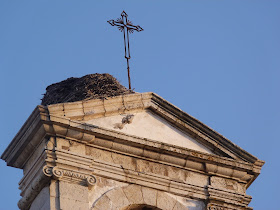A rainy day in London, but all was colour, light and clamour at Bocca di Lupo in Soho, where I had lunch the other day with the four women who are the mainstays of my writing career: from New York my literary agent Stephanie Cabot and publishing editor at HarperCollins, Jennifer Barth; and the London team: agent Araminta Whitley and Orion fiction editor, Kate Mills.
Over sublime Italian food (including a radish and celeriac salad to match the ceiling fittings...see above and below) we shared news and views, and discussed plans
for publication next summer of The Sea Garden, as the new novel is now titled. For a wonderful couple of hours I felt in the thick of it, the publishing gossip and the zeitgeist, revelling in Kate's account of how she came to admit publicly that she had turned down J K Rowling's pseudonymous detective novel for being a competent but not stand-out read (it was in a twitter exchange with author Ian Rankin, who writes the fantastic detective fiction Kate loves).
Jennifer's schedule in London was eye-opening, back-to-back meetings; I realised she is as meticulous and hardworking at the business side of publishing as she is in her editing role, and all achieved with distinct intelligence and charm. Stephanie, too, packs a lot in when she comes over - she arrived from seeing another of her UK authors in Oxford, and it's all down to her laser-sharp advice, loyalty and professionalism that I am where I am. She and Araminta - tough and funny and brilliant at spotting new trends - have been friends for a long time, and it couldn't have worked out better for me when they decided to join forces to co-agent my books.
It really was a lunch to remember, not just because it was such a treat, but because it was quite something to have all of us there together. We talked a little about my idea for a new novel, and it was good to be able to try out a few ideas (they are only ideas so far) face to face. But best of all, it was a chance for me to say thank you.
Afterwards, I popped into the National Gallery to look for the Velasquez paintings given to the nation by Sir John Hookham Frere, a distant ancestor of my husband's whose portrait hangs in our sitting room. The information surfaced in a book trail I've been following through the British bohemians and Bloomsberries. The Velasquez works in question, including St John the Evangelist at Patmos, seem not to be currently on display, but there was no chance of being unable to see the other item on my agenda: the Boris Anrep mosaics in the floor of the entrance staircase landings.

Created between 1926 and 1952, the mosaics depict figures of the day - from Churchill to Virginia Woolf, Bertrand Russell to Edith Sitwell - in evocative greens, greys and browns, with a lively dose of humour. Russian émigré Anrep's great friend Augustus John is depicted as Neptune offering Alice in Wonderland gifts from the sea. The Hollywood film star Loretta Young fills a loving cup with red and white wine to symbolise British and American friendship.
I'd been reading about Anrep in Virginia Nicholson's Among the Bohemians, which does a good job of putting famous names into social context. It prompted me to look again at a book already on my shelves, Sybille Bedford's Jigsaw, a novel in which her memories of Sanary-sur-Mer in the late 1920s and '30s are only thinly disguised. Then on to Julia, A Portrait of Julia Strachey by Herself and Frances Partridge, which is choc-full of incisive and poignant detail.
A tenuous family link here: husband's "Granny", universally loved for her great charm by young and old (she lived to a grand old age, and I was privileged to be invited to many an open house in Somerset), was a cousin of both the redoubtable biographer and Bloomsbury member Lytton Strachey, and of the artist Duncan Grant, lover of Vanessa Bell, sister of Virginia Woolf, etc, etc. Among the photographs in Julia is one of Julia Strachey aged ten, which bears a startling likeness to both husband as a child and our daughter. (Those genes must be super-strength...)
Finally, a most fruitful visit to my friend Sophie's new boutique in Sevenoaks, Kent -
The Clever Dresser (she is, very - and what's more, she can make you one too). This rambling blog post, you see, was begun in order to explain why I haven't been doing much blogging lately... Excuses, excuses, and none would be complete with the biggest excuse of them all, the writing notebook which has been simmering along nicely.


















